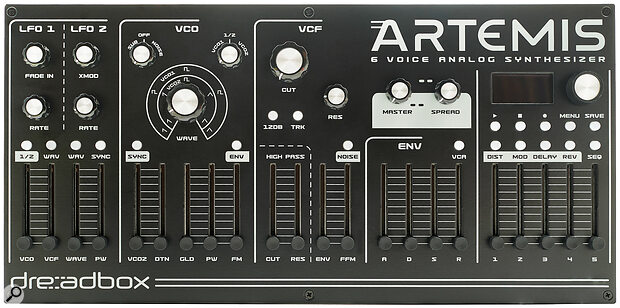Dreadbox are aiming high with the ambitious Artemis.
The Greek synthsmiths at Dreadbox have steadily built a reputation for affordable desktop analogue instruments with a satisfying helping of mojo. The Artemis slides into their portfolio at the top end with a two‑oscillator, six‑voice analogue polysynth that aims to nail the sweet spot between desktop affordability and the mythical ‘big synth’ sound. But does it succeed?
First Impressions
Out of the box, the Artemis makes a great impression. It’s compact but not cramped, with a metal chassis that feels durable and heavy. The control surface is covered with a mixture of knobs and sliders, with each section clearly delineated. A small OLED display is used for patch navigation, settings, and access to certain functions that lack front‑panel controls.
The Artemis is in desktop territory, measuring 375 x 185 x 55mm and weighing just under 2.5kg. It is on the larger end of desktop synths and avoids the toy‑like feel afflicting some other desktop devices. It’s an instrument that tries to deliver the knob‑per‑function satisfaction of flagship synths and succeeds, mostly.
One of the Artemis’ big selling points is the generous effects section, supplied by the effects gurus at Sinevibes. The effects section allows up to four stereo effects per patch, with a dedicated front‑panel control section. Whilst the synthesizer section is predominantly analogue, the effects are all digital.
Voice Architecture
At the heart of the Artemis is a true analogue signal path featuring two VCOs per voice, a sub‑oscillator, and a noise generator. Unfortunately, you cannot use both simultaneously — it’s either sub or noise, you choose. Each oscillator offers five waveshapes (sine, triangle, saw, square and noise) and can smoothly crossfade between each, although, to reduce front‑panel complexity, the waveform morphing for each oscillator is controlled by the same knob and the modulation is also shared, so if you modulate a waveform, both oscillators change equally. There is also pulse‑width modulation and hard sync.
Oscillator 1 can modulate oscillator 2’s frequency for more harmonic complexity. It’s linear FM, so you don’t suffer from the detuning problems of exponential FM, which is a welcome feature. However, the Amount slider never felt like it went far enough. The results always felt a bit tame, and it was difficult to push the synth into ‘wild’ FM territory.
Oscillator 2 can be tuned relative to the first up to two octaves in either direction. There’s also a fine‑tune slider, but this only increases the pitch of oscillator 2, which is less than ideal because if you detune a couple of oscillators, you ideally want one oscillator pitched down and one up so that the perceived centre point is perfectly in tune. You can still detune the patch overall to compensate, but this is done by accessing the patch options and adjusting the overall patch detune in the menu. The Oscillator 2 Detuned control also doubles up as a unison detune.
Unison comes in three flavours. Standard unison will stack and detune six voices for thick mono sounds. Duo Mode makes Artemis duophonic for two pairs of three‑voice unison. And finally, Tri Mode gives you three pairs of two‑voice unison. The Spread control, which bounces voices left and right, will also affect unison voices for massive stereo unison patches.
The oscillators sound rich and satisfyingly analogue, which we’ve come to expect from a Dreadbox synth. There’s a low‑end presence worthy of any good vintage polysynth, and the highs don’t sound harsh or shrill even with the filter wide open.
I am a big fan of the filter section. There are two filters: a 24dB/oct low‑pass filter with a switchable 12dB mode and a resonant high‑pass filter. There is no information about the lineage of the filter design. The low‑pass suffers a little from low‑end loss as you crank the resonance, but it’s not as severe as some, and it can scream with the best of them,...
You are reading one of the locked Subscribers-only articles from our latest 5 issues.
You've read 30% of this article for FREE, so to continue reading...
- ✅ Log in - if you have a Digital Subscription you bought from SoundOnSound.com
- ⬇️ Buy & Download this Single Article in PDF format £0.83 GBP$1.49 USD
For less than the price of a coffee, buy now and immediately download to your computer, tablet or mobile. - ⬇️ ⬇️ ⬇️ Buy & Download the FULL ISSUE PDF
Our 'full SOS magazine' for smartphone/tablet/computer. More info... - 📲 Buy a DIGITAL subscription (or 📖 📲 Print + Digital sub)
Instantly unlock ALL Premium web articles! We often release online-only content.
Visit our ShopStore.

